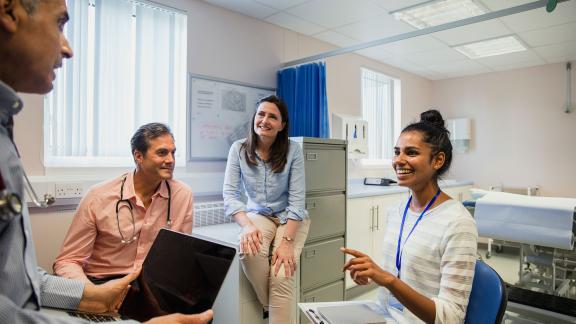Leadership Framework for Health Inequalities Improvement FAQs
29 March 2022

A national leadership framework, established to address health inequalities, allows chairs and non-executives to be creative and innovative in delivering the national vision of ‘exceptional quality healthcare for all through equitable access, excellent experience and optimal outcomes’.
The NHS Confederation delivered a programme of health inequalities improvement seminars for chairs and non-executives on provider boards within Integrated Care Systems (ICSs), supporting chairs and non-executives to investigate the specific challenges of their communities and to take effective leadership action on behalf of the most marginalised and disadvantaged people.
We have collated the most frequently asked questions arising from the seminars below, if you missed the seminars visit Leadership Framework for Health Inequalities Improvement to access the presentation slides and recording.
If you need further information or support, please contact miranda.seed@nhsconfed.org.
-
What is done best at national, system and local level?
Nationally, the Healthcare Inequalities Improvement Programme (HIqIP) is an NHS England and Improvement (NHSEI) team. It has been set up to lead work with individuals, teams, programmes, and partners with a vision to ensure exceptional quality healthcare for all through equitable access, excellent experience, and optimal outcomes. It works both on its own and with all other national programmes to ensure health inequalities is hardwired into our ways of working.
At system level, Core20PLUS5 is an approach developed by HIqIP to support NHS integrated care systems (ICSs) to reduce health inequalities. Core20PLUS5 offers ICSs a focused approach to enable prioritisation of energies and resources as they address health inequalities in the period 2021-2024. Core20PLUS5 defines a target population cohort - the ‘Core20PLUS’, and identifies five focus clinical areas requiring accelerated improvement.
Local intelligence, partnerships, asset-based approaches, and community leadership are imperative in the work to tackle health inequalities - as they have been throughout the pandemic response and in delivering equitable access to the vaccine.How can we do more as a national non-executive director (NED) community to ensure that the vision for health inequality is embedded in all our governance structures, including those with a financial and quality focus?
NEDs should use the resources on health inequalities being developed by the NHS Confederation to guide them in ensuring the vision for healthcare inequalities improvement is embedded in governance structures. Data is central in this regard to ensure accountability, including disaggregation by deprivation and ethnicity in all board performance packs. Senior responsible owners (SROs) for health inequalities should be identified in all systems and provider trusts.
Financial planning does not currently take Core20PLUS5 into account for resource allocation. Will there be a shift or national directive to enable resource to be moved around within the new integrated care systems (ICSs)?
The health inequalities and unmet need adjustment is part of the clinical commissioning group (CCG) target resource allocation. It is intended to take account of the fact that the main approach to estimating need is an analysis of met need for healthcare, and therefore may not capture need that is not met, or the objective of tackling health inequalities.
The adjustment was implemented in its current form by NHS England in 2014/15, building on the approach previously applied by the Department of Health for primary care trusts and has continued to be applied each time NHS England has set CCG allocations. It is based on a measure of premature mortality for allocations to integrated care boards (ICBs) and is used to distribute 10 per cent of the total resource allocated for core CCG services and 15 per cent of the total resource allocated for primary care.
What is envisaged for provider collaboratives working together to address priorities, including health inequalities, within ICSs?
In the 2021/22 NHS Operational Planning Guidance, local health systems were asked to report back on pre-existing disparities about access, experience and outcomes and how they were exacerbated during the pandemic. We set out five priority areas to address healthcare inequalities and continue this commitment to redouble our efforts in the latest 22/23 guidance:
- Priority 1: Restore NHS services inclusively
- Priority 2: Mitigate against digital exclusion
- Priority 3: Ensure datasets are complete and timely
- Priority 4: Accelerate preventative programmes that proactively engage those at greatest risk of poor health outcomes
- Priority 5: Strengthen leadership and accountability
At system level Core20PLUS5 is an approach developed by the HIqIP to support NHS ICSs to reduce health inequalities. Core20PLUS5 offers ICSs a focused approach to enable prioritisation of energies and resources as they address health inequalities in the period 2021-2024. Core20PLUS5 defines a target population cohort - the ‘Core20PLUS’, and identifies five focus clinical areas requiring accelerated improvement.
The engagement of community groups and trusted voices to ensure the co-production of solutions for inequality is critical. We need to enable our staff to co-produce with their communities to take actions which make a difference. Are we engaging in early conversations?
Coproduction is a key arm of the NHS England healthcare inequalities improvement strategy. The Core20PLUS5 approach asks systems to continue to use the community networks and partnerships established as part of the vaccine programme.
Take a look at this guide for ICSs on working with people and communities.
Where is the focus on building resilient communities and the contribution of anchor institutions?
The primary purpose of anchors is to support the social determinants of health and help build strong and resilient communities. A key pillar of the NHS as an anchor is working in partnership with communities, voluntary, community and social enterprise (VCSE) sector and other anchors. This is highlighted in Anchors in a Storm and guidance on VCSE in ICS partnerships. The Health Anchors Learning Network (HALN) is focusing some of its activities on this role over the next year.
Is the need to embed NHS net zero targets to build back fairer and greener after COVID-19 reflected in ICS priorities?
There is an extensive programme of activity in place to meet our net zero targets, and actions with ICSs are being developed. The greener NHS team is also working on adaptation to climate change and this will connect with wider determinants of health.
Is there an equivalent programme for executives, given that these seminars were developed for chairs and non-executives?
The NHS England and NHS Improvement HIqIP holds a monthly health inequalities improvement forum, involving SROs for health inequalities in systems and providers, and chief executives. Please contact england.healthinequalities@nhs.net for further information.
The NHS Confederation is also working to develop a leadership offering for chief operating officers. Further information on this will be available during the 2022/23 financial year.
-
When utilising the Core20PLUS5 where can I get most impact? Are there case studies available?
In collaboration with the Health Foundation and Yorkshire and Humber Academic Health Sciences Network, the HIqIT at NHS England and Improvement will be publishing 'Tackling inequalities in healthcare access, experience, and outcomes: A practical guide' in Spring 2022.
This publication will include case studies of high impact actions taken on health inequalities which are evidenced as being effective, as well as the actionable insights that span across all these case studies and can be applied by others.
More case studies are available at HIqIT NHS Futures.
Our local population is very deprived compared to the national picture, so when identifying our Core20 a large proportion of our population will be missed. Should I be using a higher percentage of Index of Multiple Deprivation (IMD)?
Rather than missing a large proportion of the population the Core20 will contain a disproportionately larger percentage of your population than the national average.
The health inequalities and unmet need adjustment is part of the CCG target resource allocation. It is intended to take account of the fact that the main approach to estimating need is an analysis of met need for healthcare, and therefore may not capture need that is not met or the objective of tackling health inequalities.
What metrics can I use to measure impact, assuming I know the target groups in the plus?
The plus groups will be locally determined. The Health Inequalities Improvement Dashboard (HIID) will contain relevant data for ethnic groups and age groups. It’s also important to use local indicators and other national programme dashboards.
What is currently available through the improvement dashboard at system level?
Speak with your ICS health inequalities lead or request access to the HIID. For more information visit future.nhs.uk and access the methodology guide.
Are there any examples of agreed datasets at national, ICS and place level already in use?
A component of the HIID is the priority wards dashboard which is available at system and priority ward level. Access comes with access to the HIID.
How will the health improvement data be evaluated nationally for performance packs?
Improved data collection and reporting will drive a better understanding of local health inequalities in access to, experience of and outcomes from healthcare services, by informing the development of action plans to narrow the health inequalities gap. Integrated care boards (ICBs), once established, and trust board performance packs are therefore expected to be disaggregated by deprivation and ethnicity.
What is the timescale for each ICS to receive its dataset?
ICSs can access data through the HIID. There are ongoing conversations with the dashboard user group about off-dashboard reporting.
What is known about the huge variation in deaths in childbirth and what is effective in tackling this?
The NHS is working to improve equity for mothers and babies and equality in experience for staff. The NHS has set out why this work is needed, the aims of this work and how the NHS will achieve its aims in two documents:
- Equity and Equality: Guidance for Local Maternity Systems. Based on the five health inequalities priorities in the 2021/22 planning guidance, this will help local maternity systems align their equality and equality action plans with ICS systems health inequalities work. The guidance includes an analysis of the evidence, interventions to improve equity and equality, resources, indicators and metrics.
- Four pledges to women, babies and staff: NHS pledges to improve equity for mothers and babies and race equality for staff. The four pledges help create a shared understanding of why work on equity and equality is needed, and the aims and outcomes of this work. The four pledges can help ‘set the scene’ in local co-production work.
What are the best sources of information or analysis on the drivers of inequality, including severe mental illness (SMI) and learning disability?
People with SMI face reduced life expectancy of 15-20 years when compared to the general population. This is driven largely by preventable physical health conditions. The latest data on this can be found at NHS Digital.
The data provided below is an excerpt of this data, which demonstrates that life expectancy for people with SMI is continuing to deteriorate.
Table one: excess premature mortality data, 2015-2017-2018-20
Time period
2015-17
2016-18
2017-19
2018-20
Increased risk of SMI dying prematurely
355%
365%
403%
451%
Times more likely to die prematurely than those without SMI
4.6X
4.7X
5.0X
5.5X
Table two: condition specific data, 2015-2017-2017-19, percentage increased risk of dying prematurely
Time period
2015-17
2016-18
2017-19
All
355%
365%
403%
Cancer
108%
113%
134%
Cardiovascular disease
301%
306%
333%
Liver disease
551%
541%
571%
Respiratory disease
511%
520%
578%
Why is the target for annual health checks for those with serious mental illness not more ambitious?
The NHS Long Term Plan sets out ambitious targets for the delivery of physical health checks. By 2023/2024, 390,000 people annually will receive a comprehensive physical health check and follow up interventions. This represents 85 per cent of the severe mental illness register.
Where can I find specific data on the prison population?
- Prison population data can be found at Prisons data - Justice data
- Prison population statistics can be found at GOV.UK
- Data disaggregated by protected characteristics can be found at: Her Majesty's Prison and Probation Service Offender Equalities Report 2020/21
How can ICSs share essential data with their providers, particularly acute trusts?
The Recovery of Critical Services Dashboard owned by the performance team at NHS England has hospital activity data broken down at trust level by health inequalities dimensions.
How confident can I be on data coding quality within the improvement dashboard?
The latest NHS Digital data shows 94.3 per cent coverage as at 27 January 2022.
Nuffield Trust analysis demonstrated that a key limitation is the over-use/ inappropriate use of the ‘other’ category.
Where are the major gaps and opportunities in regard to data coding?
A key issue identified by the Nuffield Trust is over/inappropriate use of the other category for ethnicity. The NHS Data Dictionary is aligned with the 2001 census and the goal is to move the data dictionary to be aligned with the 2021 census.
The experience element needs to be measured as well as the data. Are there any examples of this in practice?
One example is the Adult Cancer Patient Experience Survey (CPES). This year two variable analyses are being introduced to the national adult CPES results to allow for greater understanding of variation in relation to the 2021 survey results. Publication is due in early Q2 of 2022.
The analysis plan (data suppression rules allowing) is for:
- age
- gender
- IMD
- ethnicity
- tumour group
This plan applies to 2022 survey results (due in 2023) and will be available for all reporting via the dashboard at national, cancer alliance, ICS and provider level. In some areas there may be suppression of data due to very small numbers. Those providers will be able to look at some of their results from the 2022 survey at this level and decide what insight it offers them to make improvements.
-
Are there good examples of work between the NHS and local government on the underlying causes/determinants of inequality?
Joint working between the NHS and local government on the social determinants of health was accelerated because of the response to the pandemic. With the introduction of the role of ICSs to support social and economic development this valuable partnership working will increase, including through the Health Anchors Learning Network.
There are several good examples including:
- London Anchor Network - the NHS working with the Greater London Authority and many other partners across London.
- Leeds Anchor Network (LAN) - connects major Leeds organisations – including councils, hospitals, universities and utility providers – as anchors to work together to maximise the local benefits of their spending, services and recruitment.
- Working together to keep people warm in Yorkshire
- Clacton on the Sea Health Equity Programme - working across organisations to support employment opportunities.
- Army of tech angels helping people with shopping and virtual life - the NHS working with Surrey County Council, health partners, borough and district councils and voluntary, community and faith sector organisations to reduce digital exclusion and loneliness.
- Targeting positions for local people (Barts Health NHS Trust) - the trust makes a proportion of roles available to locally unemployed applicants and works closely with local authorities to identify and match potential candidates. The trust also works with schools and community partners on programmes designed to generate qualified and prepared local applicants from socially disadvantaged communities.
- Live and work scheme (Sandwell and West Birmingham Trust) - the trust is running a highly successful live and work scheme in partnership with St Basils, a registered housing association and charity. The scheme aims to bring homeless young people into safe and secure accommodation and provide a pathway to work, avoiding benefit dependency.
- Social Value Alliance (Salford) - local NHS organisations in Salford alongside organisations across the public, private, voluntary and community sectors have formed the Salford Social Value Alliance, which supports all partner organisations to deliver services and contracts with social value in mind. The Salford CCG Social Impact Report 2020 noted that the CCG had contributed to positive progress in the Salford 10 per cent better targets, with at least 1,570 more Salford residents paid the Living Wage Foundation Real Living Wage.
- Doncaster Complex Lives Alliance support for rough sleepers: Community and acute NHS Trusts and primary care in Doncaster have come together with Doncaster Metropolitan Borough Council and other related organisations to provide support to rough sleepers with complex health needs. It aims to improve outcomes for people affected by multiple disadvantages, including rough sleeping, drug and alcohol addiction, offending behaviour, mental ill-health, and poor physical health. The support model reflects the need for whole system working and an integrated response across all public services. The team is working to support 115 clients with complex needs, all of whom were rough sleepers. 90 of these are now settled and stabilised in accommodation settings, being supported by key workers and wrap-around support plans.
- Derby Healthy Housing Hub - A partnership between housing, health, social care and community. The hub aims to assist vulnerable people who are at greater risk of poor health outcomes due to unsafe or unsuitable housing. Launched in 2012, it has been crucial in identifying and tackling poor housing conditions and housing related health inequalities in the city. The hub focuses on housing living conditions that are currently impacting or have the potential to have a detrimental impact on health, particularly for those most vulnerable and in need of assistance. The service receives referrals for people who are most at risk due to their health needs and living conditions from the NHS, social care, emergency services, and the community.



